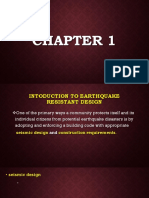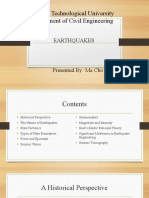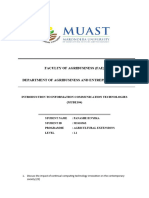0 ratings0% found this document useful (0 votes)
63 viewsRat Island Earthquake: Prepared By: Meet Patel (14CL072)
Rat Island Earthquake: Prepared By: Meet Patel (14CL072)
Uploaded by
DhruvilJakasaniyaThe 1965 Rat Islands earthquake occurred on February 4th with a magnitude of 8.7. It triggered a 10 meter tsunami on Shemya Island but caused little damage overall. The earthquake was caused by the collision of the Pacific and North American tectonic plates at a convergent boundary. The main effects were a large tsunami on Shemya Island and minor flooding and cracks in infrastructure on some of the remote, unpopulated Aleutian Islands.
Copyright:
© All Rights Reserved
Available Formats
Download as PPTX, PDF, TXT or read online from Scribd
Rat Island Earthquake: Prepared By: Meet Patel (14CL072)
Rat Island Earthquake: Prepared By: Meet Patel (14CL072)
Uploaded by
DhruvilJakasaniya0 ratings0% found this document useful (0 votes)
63 views11 pagesThe 1965 Rat Islands earthquake occurred on February 4th with a magnitude of 8.7. It triggered a 10 meter tsunami on Shemya Island but caused little damage overall. The earthquake was caused by the collision of the Pacific and North American tectonic plates at a convergent boundary. The main effects were a large tsunami on Shemya Island and minor flooding and cracks in infrastructure on some of the remote, unpopulated Aleutian Islands.
Original Description:
ytuirt678
Original Title
33
Copyright
© © All Rights Reserved
Available Formats
PPTX, PDF, TXT or read online from Scribd
Share this document
Did you find this document useful?
Is this content inappropriate?
The 1965 Rat Islands earthquake occurred on February 4th with a magnitude of 8.7. It triggered a 10 meter tsunami on Shemya Island but caused little damage overall. The earthquake was caused by the collision of the Pacific and North American tectonic plates at a convergent boundary. The main effects were a large tsunami on Shemya Island and minor flooding and cracks in infrastructure on some of the remote, unpopulated Aleutian Islands.
Copyright:
© All Rights Reserved
Available Formats
Download as PPTX, PDF, TXT or read online from Scribd
Download as pptx, pdf, or txt
0 ratings0% found this document useful (0 votes)
63 views11 pagesRat Island Earthquake: Prepared By: Meet Patel (14CL072)
Rat Island Earthquake: Prepared By: Meet Patel (14CL072)
Uploaded by
DhruvilJakasaniyaThe 1965 Rat Islands earthquake occurred on February 4th with a magnitude of 8.7. It triggered a 10 meter tsunami on Shemya Island but caused little damage overall. The earthquake was caused by the collision of the Pacific and North American tectonic plates at a convergent boundary. The main effects were a large tsunami on Shemya Island and minor flooding and cracks in infrastructure on some of the remote, unpopulated Aleutian Islands.
Copyright:
© All Rights Reserved
Available Formats
Download as PPTX, PDF, TXT or read online from Scribd
Download as pptx, pdf, or txt
You are on page 1of 11
RAT ISLAND EARTHQUAKE
PREPARED BY: MEET PATEL
(14CL072)
INTRODUCTION
• The Rat Islands are part of the Aleutian Islands, which are on
the tip of Alaska.
• The main islands that were impacted were: Adak Island,
Sheyma Island, and Attu Island.
• The 1965 Rat Islands earthquake occurred at 05:01 UTC, on 4
February (19:01, 3 February local time).
• It had a magnitude of 8.7 and triggered a tsunami of over 10
m on Shemya Island, but caused very little damage.
TECTONIC PLATES & TYPE OF FAULT
• The pacific and north american were involved.
• They collide with each other at reverse fault or
a converging plate boundary.
• Tectonic plate –
• Faults-
EFFECTS ON HUMANS
• This earthquake caused a 10 meter high
Tsunami on Sheyma Island and Floods on
Amchitka Islands.
• No one was injured or killed as it was on a
remote location.
• There was about $10,000 worth of damage
done,icluding cracks in runways on Shyema
Islands and at the U.S. Coast Guard Loran
Station on Attu Island.
REFERENCES
NGDC. "Search result for 1965 Alaska earthquakes". Retrieved 8 March 2010.
• ^ a b USGS (26 October 2009). "Historic Earthquakes Rat Islands, Alaska".
Archived from the original on 16 January 2010. Retrieved 8 March 2010.
• ^ Beck, S.L.; Christensen D.H. (1991). "Rupture Process of the February 4,
1965, Rat Islands Earthquake". Journal of Geophysical Research. 96 (B"):
2205–2221. Bibcode:1991JGR....96.2205B. doi:10.1029/90JB02092.
Retrieved 2010-03-08.
• ^ Johnson, J.M. (1999). "Heterogeneous coupling along Alaska-Aleutians as
inferred from Tsunami, Seismic and Geodetic Inversions". In Dmowska R. &
Saltzman B. Tsunamigenic Earthquakes and Their Consequences. Advances
in Geophysics. 39. pp. 28–55. ISBN 978-0-12-018839-0. Retrieved 2010-03-
08.
• ^ Abe, K. (1972). "Lithospheric normal faulting beneath the Aleutian
trench". Physics of the Earth and Planetary Interiors. 5: 109–
198. Bibcode:1972PEPI....5..190A. doi:10.1016/0031-9201(72)90091-X.
PREVENTION
• Dampers similar to the shock
Absorbers on car could have been
place as well.
• Shelves, cupboards and other things
attached with the walls could be
bolted down.
Box action in Masonry wall
• Masonry is a nonhomogeneous material,
composed of units and mortar, which can be
of different types, with distinct mechanical
properties.
• Brick masonry buildings have large mass and
hence attract large horizontal forces during
earthquake shaking.
• They develop numerous cracks under both
compressive and tensile forces caused by
earthquake shaking.
• Appropriate choice of structural configuration
can help achieve this of structural
configuration.
• To make structure Earthquake resistant, a
good box action between all the elements is
necessary.
• Good box action system means to act all the
units of building as a single unit. i.e between
roof,walls & foundation.
• For example, a horizontal band introduced at
the lintel level ties the walls together and
helps to make them behave as a single unit.
You might also like
- Caring For Muslim PatientsDocument156 pagesCaring For Muslim PatientsPddfNo ratings yet
- Mentor Observation - Myp CoordinatorDocument1 pageMentor Observation - Myp Coordinatorapi-405047057100% (1)
- EARTHQUAKE ENGINEERING PPT 1Document41 pagesEARTHQUAKE ENGINEERING PPT 1jessa aranesNo ratings yet
- 1965 Alaska EarthquakeDocument5 pages1965 Alaska EarthquakeJannin HwangNo ratings yet
- Yangon Technological University Department of Civil EngineeringDocument97 pagesYangon Technological University Department of Civil EngineeringCho WaiNo ratings yet
- Earthquakes and VolcanoesDocument53 pagesEarthquakes and VolcanoesThomas FiromumweNo ratings yet
- Earthquake PowerpointDocument6 pagesEarthquake Powerpointapi-325722144No ratings yet
- Earthquake PresentationDocument38 pagesEarthquake PresentationChris LesseyNo ratings yet
- Unit 1 Causes of EarthquakeDocument63 pagesUnit 1 Causes of Earthquakerosary originalNo ratings yet
- Earthquake EnginneringDocument11 pagesEarthquake EnginneringkkkNo ratings yet
- Earthquake DMDocument19 pagesEarthquake DMdabasjaya1908No ratings yet
- Earthquake EngineeringDocument117 pagesEarthquake EngineeringAllaineNo ratings yet
- Earthquake Resistant Design of Structures: Course InstructorDocument144 pagesEarthquake Resistant Design of Structures: Course InstructorDevinder SokhiNo ratings yet
- CH 6 Managing Natural HazardDocument82 pagesCH 6 Managing Natural Hazardtaj qaiserNo ratings yet
- Geo RevisionDocument4 pagesGeo RevisionFarfi UddinNo ratings yet
- Lesson 1 Earthquakes and FaultsDocument32 pagesLesson 1 Earthquakes and FaultsCJ SarsalejoNo ratings yet
- Earthquakes and VolcanoesDocument6 pagesEarthquakes and VolcanoesAmar KumarNo ratings yet
- December 2004 Indian Ocean Earthquake and TsunamiDocument60 pagesDecember 2004 Indian Ocean Earthquake and Tsunamiom prakashNo ratings yet
- Earthquakes: Earthquake HazardDocument30 pagesEarthquakes: Earthquake HazardMuhammad Moaz ArshadNo ratings yet
- EM EarthquakesDocument29 pagesEM Earthquakescervantes_marco74No ratings yet
- EarthquakesDocument12 pagesEarthquakesSaimanNo ratings yet
- 3 Additional Facts About EarthquakesDocument40 pages3 Additional Facts About EarthquakesAmber Zabene BarlasNo ratings yet
- TERM 2 Gr10 GeomorpologyDocument70 pagesTERM 2 Gr10 GeomorpologyJudy SissonsNo ratings yet
- 7-DISTRIBUTIONDocument24 pages7-DISTRIBUTIONwieurie74No ratings yet
- Copy of Chapter_6Document20 pagesCopy of Chapter_6ifrahkhan1311No ratings yet
- A Case Study About Sumatra Indonesia EarthquakeDocument8 pagesA Case Study About Sumatra Indonesia Earthquakeroieenjane.villapazNo ratings yet
- Elements of Earthquake EngineeringDocument41 pagesElements of Earthquake EngineeringAnjaliNo ratings yet
- Plate Tectonics 122447Document12 pagesPlate Tectonics 122447mkwa811No ratings yet
- Major of Earthquakes (Aaci0025a10)Document8 pagesMajor of Earthquakes (Aaci0025a10)Tushar SambyalNo ratings yet
- INTRODUCTION TO EARTHQUAKEDocument59 pagesINTRODUCTION TO EARTHQUAKESunil JadhavNo ratings yet
- Plate TectonicsDocument41 pagesPlate TectonicsJohn100% (1)
- CH 20Document66 pagesCH 20Tyler MroskoNo ratings yet
- Plate TectonicsDocument52 pagesPlate TectonicsTrembletonNo ratings yet
- Geo Dina MikaDocument41 pagesGeo Dina MikaAKHMAD MUTTAQINNo ratings yet
- EndogenicDocument38 pagesEndogenicAngelica SeñaNo ratings yet
- Plate Tectonics Constructive Plate MarginsDocument9 pagesPlate Tectonics Constructive Plate MarginsSara BecharaNo ratings yet
- ULO-1a - CANADA 2Document4 pagesULO-1a - CANADA 2eulbcanadaNo ratings yet
- Plate Tectonic Theory and Plate BoundariesDocument32 pagesPlate Tectonic Theory and Plate BoundariesMarben Apostol MelencionNo ratings yet
- Faults Earthquakes 1Document192 pagesFaults Earthquakes 1Gella BensonNo ratings yet
- DRRRDocument63 pagesDRRRHannah Gliz PantoNo ratings yet
- Chapter 5 Why Does Our Land Shake Violently - (Reprinted With Minor Amendments)Document31 pagesChapter 5 Why Does Our Land Shake Violently - (Reprinted With Minor Amendments)Alex ChenNo ratings yet
- Microsoft PowerPoint - 2-1ENGINEERING SEISMOLOGY PDFDocument35 pagesMicrosoft PowerPoint - 2-1ENGINEERING SEISMOLOGY PDFanfirdan taufanNo ratings yet
- The Twctonic Plate SboutDocument42 pagesThe Twctonic Plate SboutfortwicevotingsiguroNo ratings yet
- Constructiveanddestructiveforces PowerpointDocument47 pagesConstructiveanddestructiveforces Powerpointmtalley08No ratings yet
- See 2Document310 pagesSee 2Aizon SusulanNo ratings yet
- 1988 Tennant Creek EarthquakeDocument5 pages1988 Tennant Creek EarthquakeyesNo ratings yet
- Lesson 3 Deformation of CrustDocument69 pagesLesson 3 Deformation of Crustmaribeldevera razonableNo ratings yet
- Stress and Seafloor SpreadingDocument33 pagesStress and Seafloor Spreadingcentinomichelle90No ratings yet
- Earthquakes Presentation Geo Elin and TeamDocument16 pagesEarthquakes Presentation Geo Elin and TeamKrupa SathishNo ratings yet
- Earthquake Resistant StructuresDocument19 pagesEarthquake Resistant StructuresBharath Kumar H RNo ratings yet
- EARTHQUAKE-Assessment 1Document4 pagesEARTHQUAKE-Assessment 1Mark Ronnel AlvarezNo ratings yet
- DRRR EarthquakeDocument19 pagesDRRR EarthquakeIryll DaveNo ratings yet
- Earthquakes 2015Document22 pagesEarthquakes 2015api-242473496No ratings yet
- Intro Sesi1Document66 pagesIntro Sesi1jagmalNo ratings yet
- Earthquakes and VolcanoesDocument15 pagesEarthquakes and VolcanoesnhirawayneNo ratings yet
- Unit - II NewDocument14 pagesUnit - II NewRoopavathiNo ratings yet
- What Is The Difference Between Magnitude and IntensityDocument18 pagesWhat Is The Difference Between Magnitude and Intensitymark anthony NibresNo ratings yet
- Plate TectonicsDocument32 pagesPlate TectonicsVennessa KishNo ratings yet
- Earthquake Resistant Architecture Unit 1Document49 pagesEarthquake Resistant Architecture Unit 1RoopavathiNo ratings yet
- Geography PDFDocument8 pagesGeography PDFmugdha raiNo ratings yet
- ch03 Sec1 RevisedDocument35 pagesch03 Sec1 Revisedapi-239353579No ratings yet
- IEA Agri SampleDocument16 pagesIEA Agri SampleDhruvilJakasaniyaNo ratings yet
- Project Proposal For Financial Assistance Project Name Balanced Cattle Feed Manufacturing Plant (100 MTD)Document27 pagesProject Proposal For Financial Assistance Project Name Balanced Cattle Feed Manufacturing Plant (100 MTD)DhruvilJakasaniyaNo ratings yet
- Panchamrut Dairy Private LimitedDocument6 pagesPanchamrut Dairy Private LimitedDhruvilJakasaniyaNo ratings yet
- Eijmrs5242 PDFDocument7 pagesEijmrs5242 PDFDhruvilJakasaniyaNo ratings yet
- Principal Meeting VC AgendaDocument2 pagesPrincipal Meeting VC AgendaDhruvilJakasaniyaNo ratings yet
- Template For 'Skill Development System Performance'Document12 pagesTemplate For 'Skill Development System Performance'DhruvilJakasaniyaNo ratings yet
- Instructions - Desktop VerificationDocument1 pageInstructions - Desktop VerificationDhruvilJakasaniyaNo ratings yet
- Template For 'Skill Development System Performance': 1 Morva Hadaf Govt. Iti Morva Hadaf at Bamana FaliyuDocument22 pagesTemplate For 'Skill Development System Performance': 1 Morva Hadaf Govt. Iti Morva Hadaf at Bamana FaliyuDhruvilJakasaniyaNo ratings yet
- About Us - Panchamrut Dairy Official WebsiteDocument2 pagesAbout Us - Panchamrut Dairy Official WebsiteDhruvilJakasaniya100% (2)
- Benchmarking Early Literacy Skills: Developing A ToolDocument3 pagesBenchmarking Early Literacy Skills: Developing A ToolDhruvilJakasaniyaNo ratings yet
- 1 Gia Rampura-Kankanpur 2 Gia Rampura-Kankanpur 3 Gia Rampura-Kankanpur 4 Gia Rampura-KankanpurDocument24 pages1 Gia Rampura-Kankanpur 2 Gia Rampura-Kankanpur 3 Gia Rampura-Kankanpur 4 Gia Rampura-KankanpurDhruvilJakasaniyaNo ratings yet
- Monthly Attendance Submission Format For MGN FellowDocument1 pageMonthly Attendance Submission Format For MGN FellowDhruvilJakasaniyaNo ratings yet
- Name of Block (Taluka) : Data On 'Education'Document4 pagesName of Block (Taluka) : Data On 'Education'DhruvilJakasaniyaNo ratings yet
- Iti 205 - Divda ColonyDocument19 pagesIti 205 - Divda ColonyDhruvilJakasaniyaNo ratings yet
- Template For 'Skill Development System Performance'Document20 pagesTemplate For 'Skill Development System Performance'DhruvilJakasaniyaNo ratings yet
- Gate Detail: Client / DeveloperDocument1 pageGate Detail: Client / DeveloperDhruvilJakasaniyaNo ratings yet
- Professional Development Programmes NoticeDocument3 pagesProfessional Development Programmes NoticeDhruvilJakasaniyaNo ratings yet
- 1D Element - BeamsDocument54 pages1D Element - BeamsDhruvilJakasaniyaNo ratings yet
- Harikrishna Yatrik Book FormatDocument2 pagesHarikrishna Yatrik Book FormatDhruvilJakasaniyaNo ratings yet
- Construction Equipment: 1. Allround Bridging SystemDocument4 pagesConstruction Equipment: 1. Allround Bridging SystemDhruvilJakasaniyaNo ratings yet
- 03 Qualification CriteriaDocument4 pages03 Qualification CriteriaDhruvilJakasaniyaNo ratings yet
- Multipurpose Hall 108'11"X60'9" Stage: 1St Floor Plan Option-A-RevDocument1 pageMultipurpose Hall 108'11"X60'9" Stage: 1St Floor Plan Option-A-RevDhruvilJakasaniyaNo ratings yet
- Copyright Transfer FormDocument1 pageCopyright Transfer FormDhruvilJakasaniyaNo ratings yet
- Book 1Document1 pageBook 1DhruvilJakasaniyaNo ratings yet
- 6Th Floor Plan Option-A-RevDocument1 page6Th Floor Plan Option-A-RevDhruvilJakasaniyaNo ratings yet
- Col 1.5 DL+LLDocument2 pagesCol 1.5 DL+LLDhruvilJakasaniyaNo ratings yet
- 4 TH Floor School Plan Option-A-RevDocument1 page4 TH Floor School Plan Option-A-RevDhruvilJakasaniyaNo ratings yet
- Milton Bight HoldingDocument1 pageMilton Bight HoldingoperationsNo ratings yet
- Connor Silva ResumeDocument1 pageConnor Silva Resumeapi-589152156No ratings yet
- Integrated Converter With G2V V2G and DC V2V Charging Capabilities For Switched Reluctance Motor Drive-Train Based EV ApplicationDocument14 pagesIntegrated Converter With G2V V2G and DC V2V Charging Capabilities For Switched Reluctance Motor Drive-Train Based EV ApplicationhemaNo ratings yet
- Eng - Ethics Lec 1Document30 pagesEng - Ethics Lec 1Monzer OmerNo ratings yet
- Dear LP 02232024Document2 pagesDear LP 02232024Rose Anne QuisiquisiNo ratings yet
- BUD ABI AB-InBev SABMiller Presentation Analyst Call 30 August 2016Document36 pagesBUD ABI AB-InBev SABMiller Presentation Analyst Call 30 August 2016Ala BasterNo ratings yet
- Module 3 Activities:: Elective 102Document4 pagesModule 3 Activities:: Elective 102Esmareldah Henry SirueNo ratings yet
- IELTS Placement Test - ListeningDocument6 pagesIELTS Placement Test - Listeningbaochautruong01No ratings yet
- Learning DisabilitiesDocument6 pagesLearning Disabilitiesapi-367611011No ratings yet
- QSR Part 03 - Sports & OutdoorDocument24 pagesQSR Part 03 - Sports & Outdoorconwaydavid099No ratings yet
- Multi-Level Attention Network Using Text, Audio and Video For Depression PredictionDocument8 pagesMulti-Level Attention Network Using Text, Audio and Video For Depression Predictionstevenh.vargasNo ratings yet
- Assignment 1 M241036Z Panashe NyikaDocument7 pagesAssignment 1 M241036Z Panashe Nyikapanashenyika34No ratings yet
- Articulos Sensorial-2020-2Document1 pageArticulos Sensorial-2020-2Wendy Núñez BedollaNo ratings yet
- TOF Camera WhitePaperDocument10 pagesTOF Camera WhitePaperaaaNo ratings yet
- Original PBE PRM 01 Rev 21 Date 8 28 15Document62 pagesOriginal PBE PRM 01 Rev 21 Date 8 28 15MEDDEB HSANNo ratings yet
- Bansal BillDocument1 pageBansal Billwanna.wohNo ratings yet
- Ajaran Pembebasan Dalam LontarDocument10 pagesAjaran Pembebasan Dalam LontarNOWHERE-MANNo ratings yet
- Project Report Dary FarmDocument7 pagesProject Report Dary FarmAbdul Hakim ShaikhNo ratings yet
- Ipp Ielts - Aim 6+ - Pre-Course - File WordDocument15 pagesIpp Ielts - Aim 6+ - Pre-Course - File WordTrương NhiNo ratings yet
- DTR Lomo Luxury 9-12 ANGDocument114 pagesDTR Lomo Luxury 9-12 ANGZlajaNo ratings yet
- TOP 250 Construction CompanyDocument9 pagesTOP 250 Construction CompanyDono WayNo ratings yet
- Plagiarism Exercise Case Study NewDocument5 pagesPlagiarism Exercise Case Study NewLaToya AbduhNo ratings yet
- The Interactionist Approach On Education: Submitted By: Haris Johar Submitted To: Dr. Habib Elahi Roll Number: 44872Document6 pagesThe Interactionist Approach On Education: Submitted By: Haris Johar Submitted To: Dr. Habib Elahi Roll Number: 44872tasneemNo ratings yet
- Central Warehousing Corporation Recruitment 2024Document5 pagesCentral Warehousing Corporation Recruitment 2024swagatrs01No ratings yet
- Triple TalaqDocument18 pagesTriple TalaqRaja IbrahimNo ratings yet
- Argumentative Essay OutlineDocument3 pagesArgumentative Essay Outlineapi-547671509No ratings yet
- Shri Kshetra GanagapurDocument28 pagesShri Kshetra GanagapurGurudas PaiNo ratings yet
- Strategic Control Strategic ManagementDocument4 pagesStrategic Control Strategic ManagementJagdesh SinghNo ratings yet




















































































































